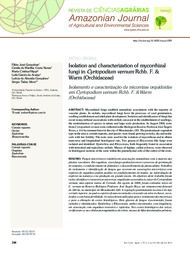Isolation and characterization of mycorrhizal fungi in Cyrtopodium vernum Rchb. F. & Warm (Orchidaceae).
Isolation and characterization of mycorrhizal fungi in Cyrtopodium vernum Rchb. F. & Warm (Orchidaceae).
Author(s): GONÇALVES, F. J.; NUNES, C. de M. C.; FILIPPI, M. C.; ARAÚJO, L. G. de; GONÇALVES, L. de A.; SIBOV, S. T.
Summary: Mycorrhizal fungi establish mutualistic associations with the majority of vascular plants. In orchids, mycorrhizal fungi favor the processes of seed germination, seedling establishment and adult plant development. Isolation and identification of fungi that occur in mycorrhizal associations with orchids can assist in the establishment of seedlings, the reintroduction of species in nature and large-scale production. In August 2008, roots from Cyrtopodium vernum were collected in the Biological Reserve Professor José Ângelo Rizzo, a 144-ha remnant forest in the city of Mossâmedes, GO. The predominant vegetation type in the area is cerrado rupestre, and species were found growing in rocky, dry and acidic soils with low fertility. The roots were used for the isolation of mycorrhizae and to obtain transverse and longitudinal histological cuts. Two genera of Rhizoctonia-like fungi were isolated and identified: Epulorhiza and Rhizoctonia, both frequently found in association with terrestrial and rupicolous orchids. Masses of hyphae, called pelotons, were observed in histological sections of the roots within the parenchymal cells of the cortex of the roots.
Publication year: 2014
Types of publication: Journal article
Unit: Embrapa Rice & Beans
Observation
Some of Embrapa's publications are published as ePub files. To read them, use or download one of the following free software options to your computer or mobile device. Android: Google Play Books; IOS: iBooks; Windows and Linux: Calibre.
Access other publications
Access the Agricultural Research Database (BDPA) to consult Embrapa's full library collection and records.
Visit Embrapa Bookstore to purchase books and other publications sold by Embrapa.

